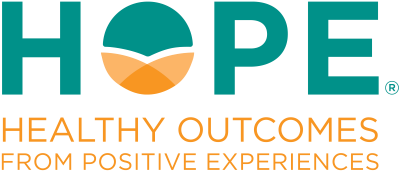
HOPE helps you shift from seeking deficits to championing the positive
HOPE is an actionable and accessible framework centered on promoting positive childhood experiences (PCEs) for children and families. In particular, HOPE centers around four key types of PCEs that we group as the Four Building Blocks of HOPE:
- Safe and supportive relationships
- Safe and stable environments
- Opportunities for social and civic engagement
- Opportunities for emotional growth
The HOPE framework enables professionals, organizations, and communities to shift their focus from solely identifying deficits and trauma to also recognizing strengths and building resilience. By understanding both children and families’ past hardships and current (and future) strengths, we see them as whole people and more adequately determine their unique needs for the PCEs missing in their lives.
What is Type 1 and Type 2 thinking?
Incorporating the HOPE framework often requires deliberately slowing down our thinking. A core component in all our HOPE trainings, including presentations, workshops, and online courses, is the challenge of Type 1 and Type 2 thinking. It is important to understand how we can leverage our thinking to promote more PCEs for the children and communities around us.
Fast and unfiltered: Type 1 thinking
Type 1 thinking is fast, unfiltered, and does not allow for much time to think through the implications of our thoughts and actions. It is our gut response to something.
When we use Type 1 thinking, we react to the situation before we think through any decisions or thoughts. Unfortunately, this can lead to us relying on biases and assumptions. The last thing we want to do when helping children and families is to perpetuate racism, sexism, homophobia, xenophobia, and other systemic barriers that prevent the promotion of PCEs.
The good news is that Type 2 can help.
Slow and curious: Type 2 thinking
Type 2 thinking is slow, curious, and thoughtful. It allows us to create time and space to filter our thoughts and understand the reasoning behind our decisions and thoughts. Type 2 thinking helps us review our thoughts for any bias or assumptions.
And for many of us, practicing the HOPE framework is not fast thinking. We have to take time to see each child and family fully. What are all their experiences, both good and bad? What PCEs do you already see in their lives? What does each Building Block look like to them? Which Building Blocks should you prioritize to promote more PCEs?
When we embrace Type 2 thinking, we can better seek the positive and set up each child and family for a healthier future.
What does Type 2 thinking look like in practice
Opportunities to practice thoughtful Type 2 thinking can happen every day. A great way to exercise slower thinking is by keeping the Four Building Blocks of HOPE at the front of our minds. Think about every interaction with children and families, every meeting with colleagues, and every organizational policy, program, and practice. How can you include the Building Blocks in every situation?
When speaking directly with children, ask questions that reveal what is going well for them and listen for the Building Blocks they are experiencing. For instance:
- Relationships: Who are the people that bring them the most joy?
- Environment: Where do they feel the safest?
- Engagement: What activities or hobbies do they enjoy?
- Emotional growth: Did they recently feel supported through a difficult event or emotion?
Type 2 thinking can also be used in leadership roles to prevent burnout, improve organizational culture, and boost morale for staff members. Staff need positive experiences too! Slower thinking can help organizations understand their work culture with greater intention and see what Building Blocks are present and needed.
What is an example of Type 2 thinking?
A parent is late for an appointment with their two young children. As their provider, you stressed the importance of the follow-up appointment in the last session and sent reminder calls and texts. You feel frustrated that they are not on time.
Using Type 1 thinking, you might respond with:
- “This individual doesn’t care about my time and my services.”
- “Clearly, they are not motivated to show up.”
- “Maybe they are just too lazy to care.”
On the flipside, with Type 2 thinking, you might think:
- “What are the barriers that could prevent them from being on time?
- “How are they getting here? Do they have reliable transportation?”
- “If I were in their shoes, what would prevent me from making an appointment on time?”
How would you respond to this situation?
Learn how to promote PCEs in your work
If you want to learn more about the HOPE framework and how to promote PCEs in your work, sign up for a workshop or start taking our online courses today!


